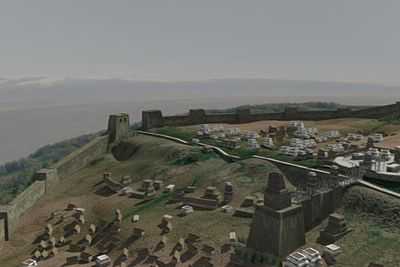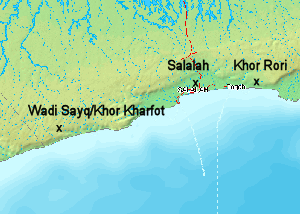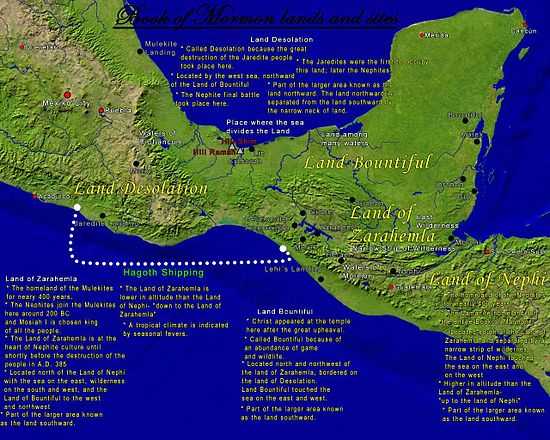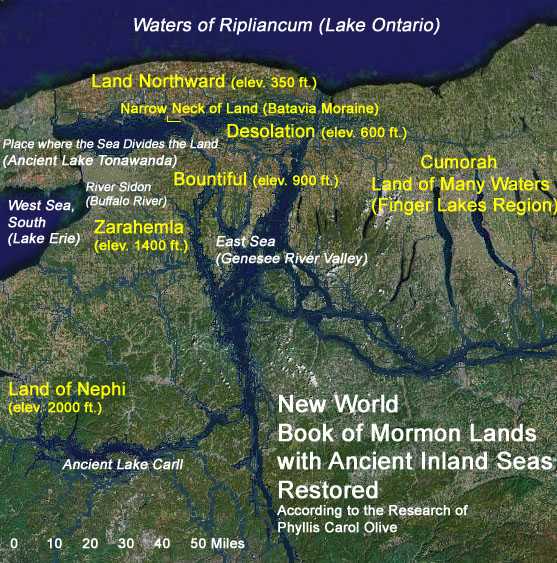Bountiful (Book of Mormon)

Bountiful is the name of two places described in the Book of Mormon, a religious narrative dictated in 1829 by Joseph Smith, Jr. The first location is set in the Old World near Jerusalem, and the second location is set somewhere in the Americas. While secular and non-Mormon scholars consider the Book of Mormon to be a work of fiction, Latter Day Saints view the book as a chronicle of actual indigenous American people. Accordingly, several LDS scholars have attempted to coordinate the Book of Mormon text relating to Bountiful with actual locations in the Old World and the New World.
The Book of Mormon references have inspired Mormon settlers to give the name Bountiful to two towns: Bountiful, Utah and Bountiful, British Columbia.
Old World
In the First Book of Nephi in the Book of Mormon, Bountiful is described as a lush land on the coast containing "much fruit and also wild honey" where Lehi and his party settle temporarily before building their ship (1 Nephi 17:5). After the ship is completed, Lehi's party departs Bountiful and sails to the Americas. (See Archaeology and the Book of Mormon.)
Sea "Irreantum"
Upon their arrival at the coast, the Book of Mormon states that Lehi's group named the sea Irreantum, which is said to mean "many waters" (1 Nephi 17:5).[1] Anciently, the Arabian Sea was referred to by the Latin name Mare Erythraeum. LDS researchers Lynn and Hope Hilton point out the similarity between the words Irreantum and Erythraeum (Hilton & Hilton 1996, p. 21).[2]
Speculative real world locations
A few LDS scholars believe that the location of Bountiful can be correlated with any of several locations on Oman's southern Dhofar coast on the Arabian peninsula. Locations that have been evaluated are Wadi Hajr (Yemen), Wadi Masilah (Yemen), Dhalqut (Oman), Rakhyut (Oman), Salalah (Oman) and Wadi Sayq/Kohr Kharfot (Oman) (Aston & Aston 1994, pp. 37–43). In order to match the characteristics outlined in the Book of Mormon, Aston suggests that there are 12 different requirements that a viable candidate for Bountiful must meet (Aston & Aston 1994, pp. 28–9):

- The location must lie nearly eastward of Nahom (1 Nephi 17:1).[3]
- The coast must be accessible from the interior desert.
- Both the general area and the location when the Lehites camped must be fertile and capable of producing crops.
- It must be a coastal location (1 Nephi 17:5).
- It must be very fertile, with "much fruit and also wild honey" and small game (1 Nephi 17:5-6).
- Timber must be available with which to build a ship (1 Nephi 17:8).
- Freshwater must be available year-round.
- A mountain must be located nearby to account for Nephi's reference to going to a mountain to "pray oft" (1 Nephi 18:3).
- Cliffs overlooking the ocean must be present to account for Nephi's brother's attempt to throw him "into the depths of the sea" (1 Nephi 17:48).
- Ore and flint must be available with which to make fire and fabricate tools to build a ship" (1 Nephi 17:9)
- No resident population at the time of the Lehite's arrival.
- Wind and ocean currents capable of carrying a ship out into the ocean (1 Nephi 18:8)
After visiting and evaluating every site on the southern Arabian coast that might qualify as Bountiful, Aston concluded that all sites were found to be incapable of meeting every one of these requirements with the exception of Wadi Sayq/Khor Kharfot (Aston & Aston 1994, p. 43). One small group of researchers however favor the location of Khor Rori 40 kilometers to the east of Salalah.[4]
Wadi Sayq/Khor Kharfot
Aston concluded that the Wadi Sayq/Khor Kharfot site meets all of the requirements to qualify as Nephi's Bountiful (Reynolds 1997, p. 383). Most LDS researchers now believe that the Wadi Sayq (River Valley) and Khor Kharfot (Fort Inlet or Port) site is the most viable candidate, and discount other potential sites as they lack key aspects of the "Bountiful" described by Nephi (Chadwick 2005). Reynolds describes how only this location meets the requirements described by Aston (Reynolds 1997, pp. 384–7):
- Khor Kharfot is situated less than one degree from due east of Nehem (Nahom).
- The valley of Wadi Sayq leads to the ocean from the desert interior, and is the only wadi that flows from the high desert eastward toward the coast. The coast is accessible by traveling through the bottom of Wadi Sayq.
- Khor Kharfot is the most fertile site on the southern Arabian coast. The region of fertility extends two miles into the Wadi Sayq.
- There is evidence of inhabitation and use as a small seaport during the Islamic period. Water was available through freshwater springs and an ancient river.
- A number of sizable trees exist in the area, with evidence of ancient forests. These trees could have provided sufficient lumber to build a ship (Reynolds 1997, p. 385).[5]
- Khor Kharfot has the largest permanent flow of fresh water of any site on the coast.
- A large mountain overlooks the west end of the beach.
- Cliffs rise above the ocean in this area.
- Iron in the form of specular hematite is available in the Marbat plain, within a few days' hike to the east of Khor Kharfot.
- A form of flint is available on the surface in large quantities.
- Ancient ruins show that Khor Kharfot was occupied intermittently, although it is currently uninhabited.
- The coast is well suited to sailing, with seasonal winds in the fall blowing east.
Salalah
In Mormon culture, the most popular traditional location of Bountiful is Salalah in modern Oman. LDS scholar Hugh Nibley first proposed this location as Nephi's Bountiful in an article published in the Improvement Era in 1950. Nibley's conclusion was based upon early writings describing life in Arabia, including an account describing the fertile Salalah area written by English explorer Bertram Thomas (Aston 1998).
Khor Rori
Khor Rori is an Iron Age port about 40 kilometers east of Salalah (Phillips 2000), and was not used as a seaport until hundreds of years after the account of Nephi took place.
New World

The Book of Mormon refers to a city on the American continent called Bountiful. It holds a significant importance in the book as the place where Jesus Christ is said to have visited people in the Book of Mormon civilization after his resurrection. As with most Book of Mormon place names, secular scholars consider the New World Bountiful to be a fictional location. However, LDS archeologist John Sorenson believes it to have been in what today is the Mexican State of Tabasco.[6]

Other LDS argue that the New World land and city of Bountiful cannot possibly be very distant from the location of the land Cumorah given in LDS scripture. This interpretation understands the Cumorah described in the Book of Mormon to be identical to the Cumorah mentioned in Doctrine and Covenants 128:20. [7]
Notes
- ↑ "And we beheld the sea, which we called Irreantum, which, being interpreted, is many waters."
- ↑ "The Greeks of the first century A.D. called this sea ERYTHRAEM (sic)."
- ↑ "...we did travel nearly eastward from that time forth"
- ↑ Book of Mormon Explorers Claim Discoveries, Nephi Project
- ↑ Reynolds states that the ancient Omani on the Dhofar coast constructed an unusual type of vessel called a sewn boat. Fleets of these sewn boats were used by the Omani to maintain trade between Mesopotamia, Africa, India and China over a 5000-year period, earning the ancient Omani recognition as the Phoenicians of the Indian Ocean.
- ↑ Sorenson 1985, pp. 43–44
- ↑ Doctrine and Covenants 128:20, Olive, Phyllis Carol; see also Coon, W. Vincent, "How Exaggerated Settings for the Book of Mormon Came to Pass"
References
- Aston, Warren P; Aston, Michaela Knoth (1994), In the Footsteps of Lehi: New Evidence for Lehi's Journey across Arabia to Bountiful, Salt Lake City, UT: Deseret Book Company, ISBN 978-0-87579-847-9.
- Aston, Warren (1998), "The Arabian Bountiful Discovered? Evidence for Nephi's Bountiful", Journal of Book of Mormon Studies (Maxwell Institute) 7 (1): 4–11, retrieved 2007-01-04.
- Chadwick, Jeffery R (2005), "The Wrong Place for Lehi's Trail and the Valley of Lemuel", Journal of Book of Mormon Studies (Foundation for Ancient Research and Mormon Studies) 17 (2): 197–215, retrieved 2007-01-04.
- Hilton, Lynn M; Hilton, Hope A (1996), Discovering Lehi: New Evidence of Lehi and Nephi in Arabia, Springville, Utah: Cedar Fort, Inc., ISBN 1-55517-257-1.
- Phillips, William R (2000), "Metals of the Book of Mormon", Journal of Book of Mormon Studies (Maxwell Institute) 9 (2): 36–43, retrieved 2007-01-04.
- Reynolds, Noel B (1997), "Lehi's Arabian Journey Updated", Book of Mormon Authorship Revisited (Provo, Utah: Foundation for Ancient Research and Mormon Studies), ISBN 0-934893-25-X.
- Sorenson, John (1985), An Ancient American Setting for the Book of Mormon, Deseret Book Company, ISBN 0-87747-608-X.
External links
- Khor Rori - Sumharam, retrieved 2007-01-05
- Nephis Bountiful in Arabia: The Book of Mormon (YouTube)